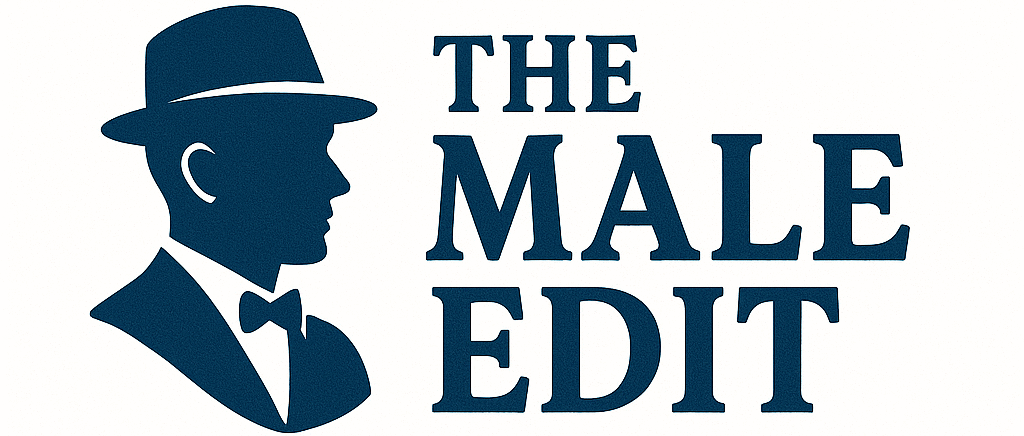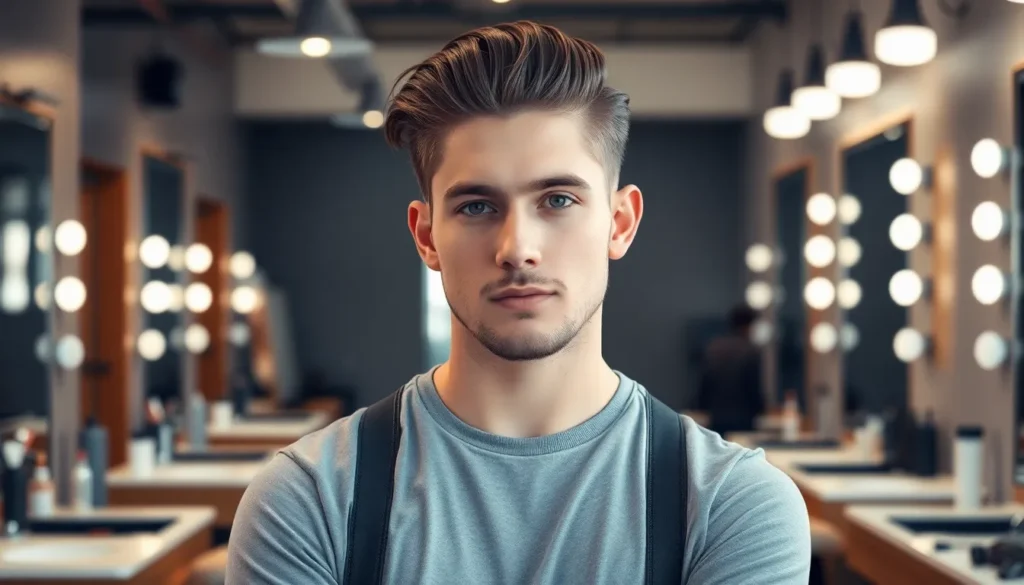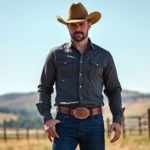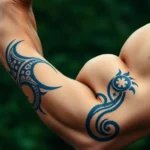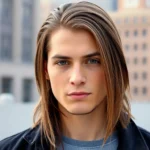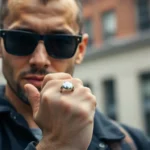We’ve all seen those effortlessly stylish guys who somehow make long hair look both rugged and refined at the same time. The secret? They’ve mastered the art of the long hair men’s undercut – a versatile style that’s taken the grooming industry by storm and isn’t slowing down anytime soon.
This edgy combination gives you the best of both worlds: length on top for styling flexibility and clean-shaved sides that add structure and sophistication. Whether you’re heading to a board meeting or weekend festival we’ll show you exactly how to achieve that perfect balance between professional polish and rebellious charm.
The long hair undercut isn’t just another trend – it’s a statement piece that works with virtually any hair texture and face shape. From subtle disconnected cuts to bold high-contrast styles we’re about to jump into everything you need to know to rock this game-changing look with confidence.
Classic Long Hair Undercut With Slicked Back Top
The classic long hair undercut with slicked back top represents the perfect marriage of refined elegance and modern edge. This sophisticated style transforms traditional long hair into a polished statement that works seamlessly for professional meetings and evening events.
How to Style and Maintain the Look
Achieving this timeless style requires proper preparation and technique to create that signature smooth finish. Begin with damp hair using a wide tooth comb to distribute product evenly from roots to ends. Apply your chosen styling product while hair maintains slight moisture for optimal hold and shine.
Work the product through your hair using your fingers first, then switch to a fine tooth comb for precision. Comb everything straight back from your hairline, ensuring no strands escape the sleek silhouette. Create tension while combing to achieve maximum smoothness and control.
Blow dry on medium heat while continuing to comb backward, maintaining the slicked direction throughout the process. Focus the airflow from roots to tips to seal the cuticle and enhance shine. Allow the hair to cool completely while still combed back to set the style.
Touch ups throughout the day require minimal effort with this low maintenance approach. Smooth any loose pieces with slightly damp hands or a small amount of additional product. Regular trims every 6 to 8 weeks keep the undercut sharp and the top length manageable.
Best Hair Products for This Cut
Strong hold pomades deliver the foundation for this classic slicked back style with superior staying power. Water based pomades offer excellent control while remaining easy to wash out at the end of the day. Oil based options provide longer lasting hold and enhanced shine for special occasions.
Hair wax creates texture and flexibility when you want a less rigid finish than traditional pomade provides. Matte finish waxes work well for casual settings while still maintaining the slicked back shape. Cream based products offer medium hold with natural movement for everyday wear.
Finishing sprays lock your style in place and provide additional protection against humidity and wind. Heat protectant sprays become essential when using blow dryers or other heated styling tools regularly. Leave in conditioners help maintain hair health while adding subtle shine and manageability.
| Product Type | Hold Level | Finish | Best For |
|---|---|---|---|
| Water Based Pomade | Strong | High Shine | Daily Wear |
| Oil Based Pomade | Maximum | High Shine | Special Events |
| Hair Wax | Medium | Natural/Matte | Casual Settings |
| Styling Cream | Light-Medium | Natural | Everyday Use |
Quality tools enhance your styling routine and help achieve professional results at home. Invest in a fine tooth metal comb for precise sectioning and smooth distribution. Wide tooth combs work best for initial product application without causing breakage or tangles.
Textured Long Hair Undercut With Messy Top
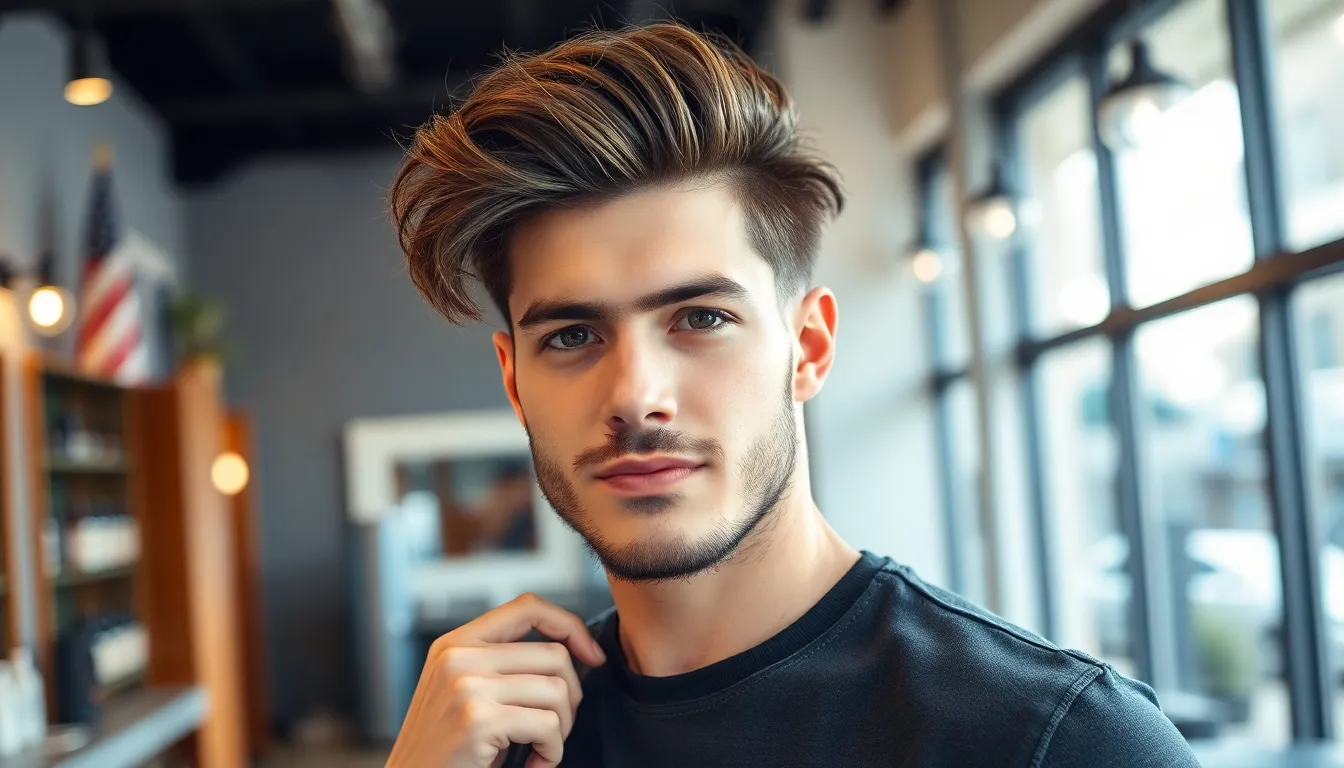
We’ve found that the textured long hair undercut with messy top perfectly balances modern edginess with casual appeal, creating a sharp contrast between closely shaved sides and voluminous, textured hair on top. This versatile style adapts beautifully to straight, wavy, or curly hair types while maintaining that effortless, lived-in appearance.
Creating Natural Movement and Volume
Texture sprays and sea salt sprays become our go-to products for achieving natural movement without weighing down the hair. We recommend applying these light-hold styling products to damp hair, working them through from mid-length to ends for optimal distribution.
Styling wax or mousse works exceptionally well when applied to individual locks, creating separation and that coveted lived-in texture. For those with straight hair, we suggest backcombing the roots before applying texturizing products to build substantial volume at the base.
Tousling the hair with fingers or a wide-tooth comb encourages that relaxed, effortless finish we’re aiming for. We’ve discovered that this finger-styling technique maintains the natural movement while preventing the style from looking overly structured.
Volume-building techniques vary depending on your hair’s natural texture, but the key remains consistent: less is more when it comes to product application. We focus on improving what’s already there rather than forcing unnatural texture.
Styling Tips for Different Hair Types
Wavy hair responds beautifully to texture or sea salt spray application, which enhances those natural wave patterns without creating stiffness. We finish with a light-hold wax for separation and frizz prevention, ensuring the waves remain defined yet touchable.
Curly hair requires a different approach where we apply curl-defining cream or mousse to damp hair before air drying or using a diffuser. We add a small amount of oil or serum to control frizz while maintaining those bouncy, well-defined curls that contrast beautifully with the undercut sides.
Straight hair benefits from volume-building techniques like blow-drying upside down or incorporating volumizing powder at the roots. We then apply texturizing spray for added movement and that perfectly tousled effect that makes the style look effortless.
Universal application across all hair types means avoiding heavy product overload, as our goal remains achieving that natural, textured appearance that highlights the dramatic contrast with the undercut sides. We recommend regular trims to keep the long top healthy while maintaining the sharpness of the undercut.
Long Hair Undercut With Man Bun
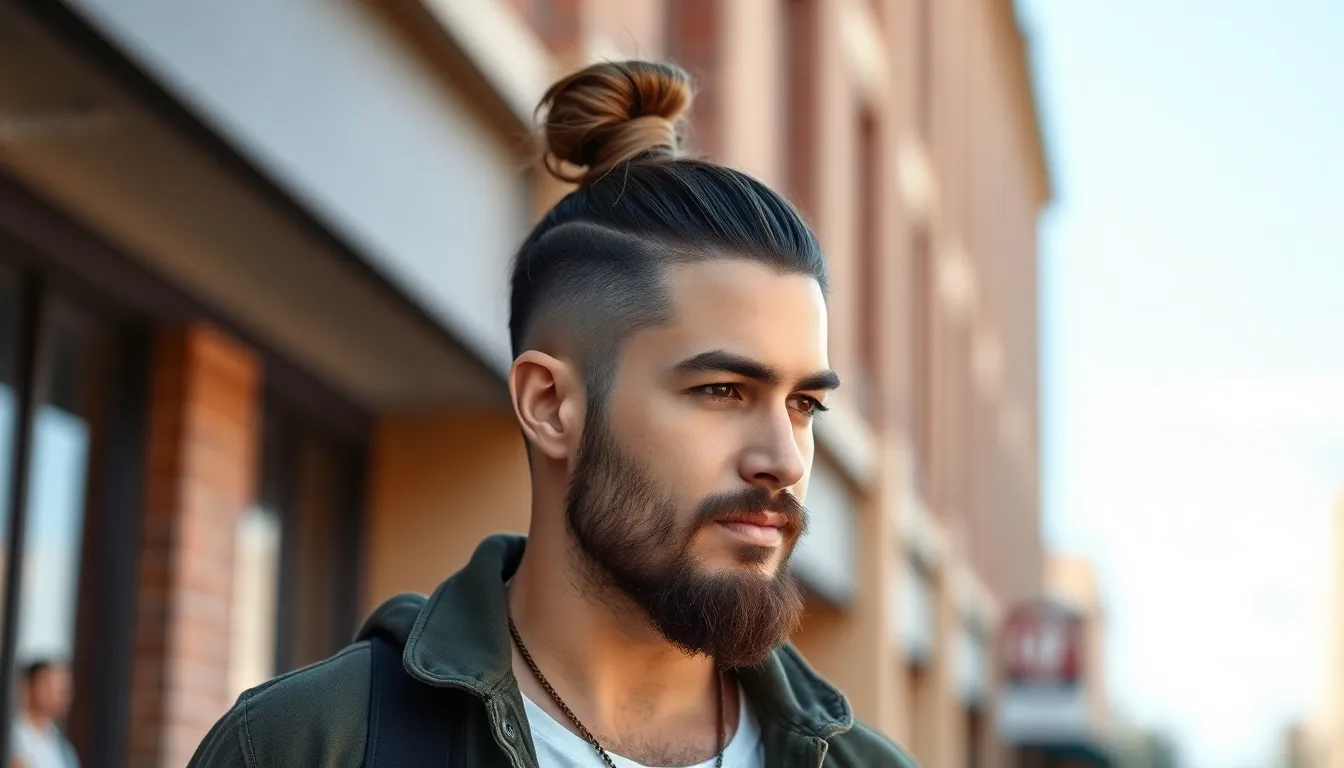
The long hair undercut with man bun elevates your style game by combining the sophisticated contrast of short sides with a versatile top knot. This ever-changing look transforms your long hair into a functional yet fashionable statement that works seamlessly from boardroom to weekend adventures.
Proper Bun Placement and Technique
Positioning your man bun correctly starts with identifying the optimal height for your head shape and personal style preferences. Most men find success securing their bun towards the back of the head, creating a balanced silhouette that complements the undercut’s clean lines.
Gathering your long hair requires a gentle approach to avoid creating unwanted bumps or loose sections. Start by brushing your hair straight back from the hairline, ensuring all strands flow smoothly toward your chosen bun location.
Securing the bun involves wrapping a hair elastic around your gathered hair, then twisting the ponytail and wrapping it around the base. The disconnected undercut style creates a striking contrast where the very short lower sections meet the longer top hair, producing that sought-after sleek appearance.
Tightening the final result means adjusting the bun’s position and ensuring all flyaways are controlled. The key lies in achieving that perfect balance between the sharp, clean undercut and the textured fullness of your top knot.
Variations for Different Face Shapes
Oval face shapes benefit most from the classic undercut man bun placement, as this natural balance maintains perfect symmetry without overwhelming your facial features. We recommend positioning your bun at medium height to enhance your face’s natural proportions.
Square face shapes work exceptionally well with a rounded back undercut man bun, which softens those strong angular features that define your jawline. This variation creates curves that complement rather than compete with your facial structure.
Round face shapes gain definition through a diamond back undercut man bun, adding essential angles and visual interest to balance your softer features. The pointed finish at the back creates vertical lines that elongate your overall appearance.
Triangular face shapes achieve better proportion with a low back undercut man bun, helping balance your broader forehead with your narrower chin area. This placement draws attention to the middle section of your face while maintaining overall harmony.
Disconnected Undercut With Long Flowing Hair
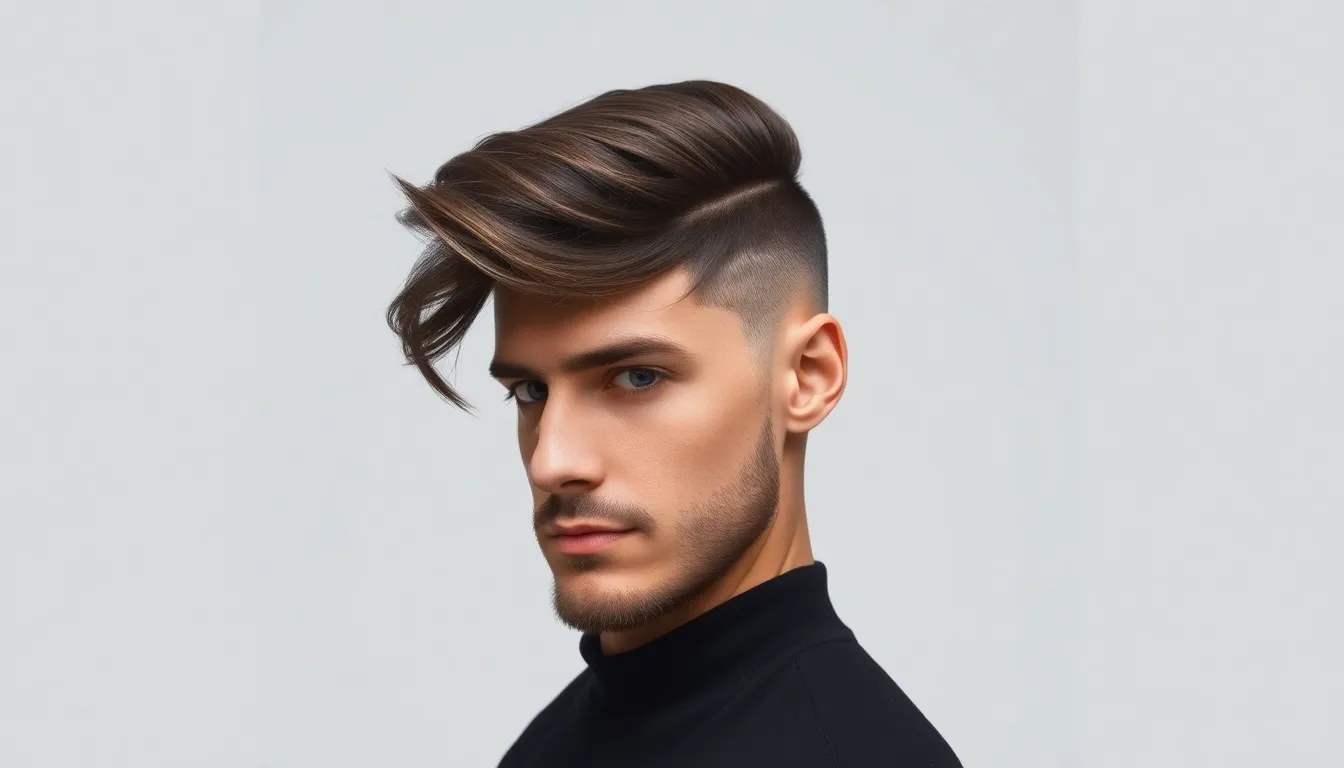
This striking style creates one of the most dramatic contrasts we’ve seen in men’s long hair undercuts. The disconnected undercut allows your flowing hair to cascade naturally while maintaining clean, defined edges.
Understanding the Contrast Effect
Disconnected undercut styling emphasizes the visual separation between short sides and long flowing hair on top. This sharp contrast creates a bold, modern aesthetic that draws attention to the hair’s natural movement and texture. We find this style particularly effective because it accommodates various face shapes while highlighting the versatility of long hair.
The flowing hair creates dramatic movement that contrasts beautifully with the sleek, trimmed sides. Face shape compatibility becomes a major advantage, as the style’s proportions can be adjusted to enhance your natural features. Hair types ranging from straight to wavy benefit from this contrast, with each texture adding its own character to the overall look.
Maintenance Requirements and Growing Out Tips
Regular maintenance becomes essential for keeping the disconnected look sharp and defined. We recommend scheduling trims every two to three weeks to maintain the precise contrast between lengths.
Styling products like pastes and clays help define the top section while adding texture and movement. These products work particularly well for creating separation in long flowing hair without weighing it down.
Growing out the sides requires patience and strategic planning to avoid awkward transition phases. Gradual lengthening works better than letting the sides grow out completely, as this maintains some contrast throughout the process.
Blending techniques become crucial when transitioning from the disconnected look to a more connected style. Professional barbers can help merge the longer hair with shorter sides using layering methods that create smooth transitions.
Consultation with experienced barbers ensures you achieve the best results during both maintenance and growth phases. Their expertise helps navigate the complex process of maintaining or changing this distinctive style.
Long Hair Undercut With Braided Elements
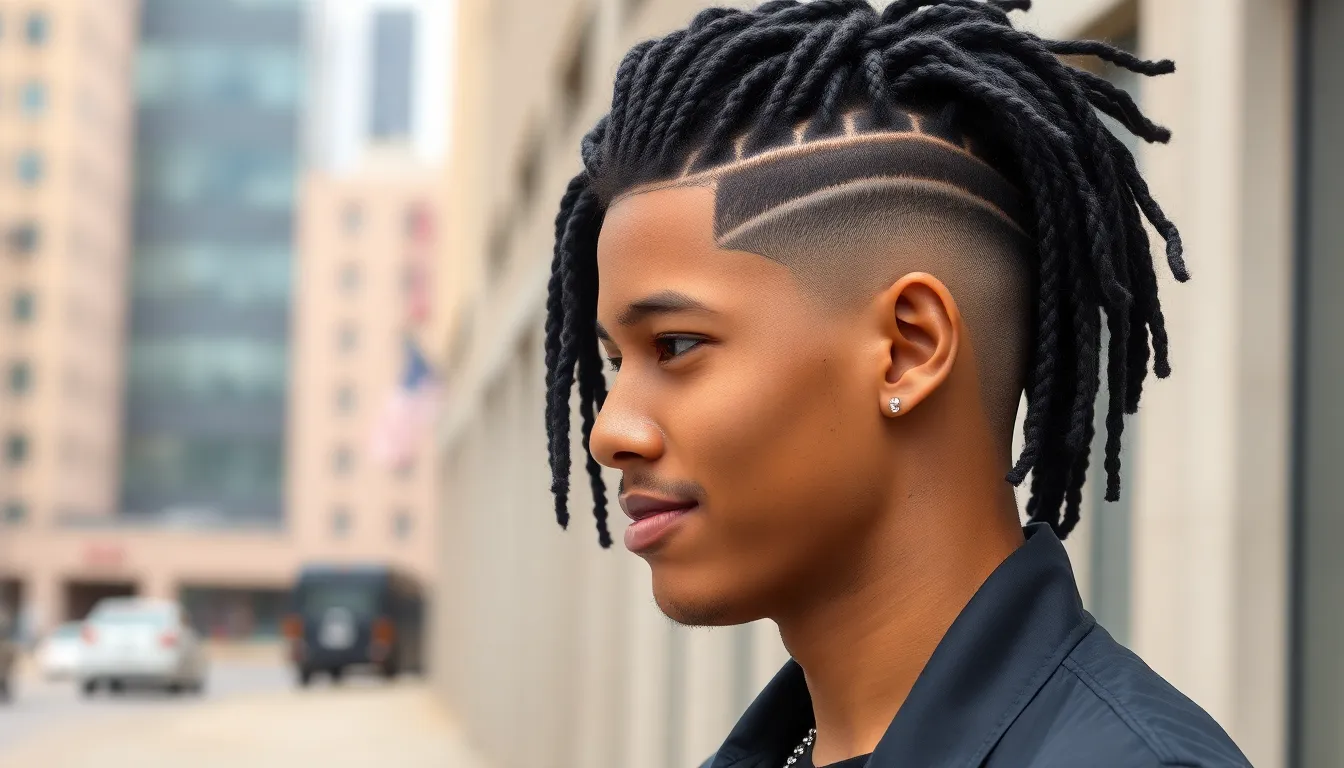
Braided elements transform the traditional long hair undercut into an artistic statement piece that combines modern edge with cultural heritage.
Incorporating Braids Into Your Style
Men with long hair can brilliantly combine braids with undercut hairstyles for a striking and versatile look. Popular braid styles include cornrows, box braids, French braids, and single or multiple long braids that create stunning contrasts against the shaved sides.
The technique involves shaving or clipping the sides and back very short while styling the longer top section into various braided patterns. We’ve seen fashionable approaches like creating V-shaped undercuts that mimic mohawk effects while the braided top gets tied into buns or left cascading loose.
Twisted braids cascading from the top onto clean undercuts add sophisticated texture, especially when paired with precise hairlines and neat braid ends. These styles adapt beautifully to waves, curls, and straight hair textures, offering flexibility for different hair types.
Maintenance requires keeping the undercut trimmed regularly every two to three weeks while ensuring braided sections stay neat and secure. Securing braid ends with quality ties prevents unraveling, particularly important for silky or fine hair textures that tend to slip.
Variations allow for extensive personal customization, from sleek ponytail braids to half-up braided styles, and from symmetrical cornrows to bold one-sided long braids. Each approach delivers unique visual impact while maintaining the sharp contrast that defines this hybrid style.
Cultural Considerations and Modern Adaptations
Braids carry rich cultural significance in many communities worldwide, symbolizing identity, heritage, and tradition that we must acknowledge and respect. Different braid types such as cornrows have historical roots in African and African American culture, representing centuries of artistic expression and community connection.
Modern fashion sees men from diverse backgrounds adapting braids into contemporary styles, integrating them with current trends like undercuts to make personal or cultural statements. We encourage understanding these origins while appreciating how braided undercuts contribute to evolving hairstyles that blend cultural history with individual expression.
Today’s interpretations balance respect for traditional techniques with modern aesthetics, creating styles suitable for formal, casual, or creative environments. This fusion emphasizes sharp contrasts, creative shapes in shaved sections, and versatile braided styling that produces visually appealing and meaningful haircuts for diverse personalities and textures.
Fade Undercut With Long Hair on Top
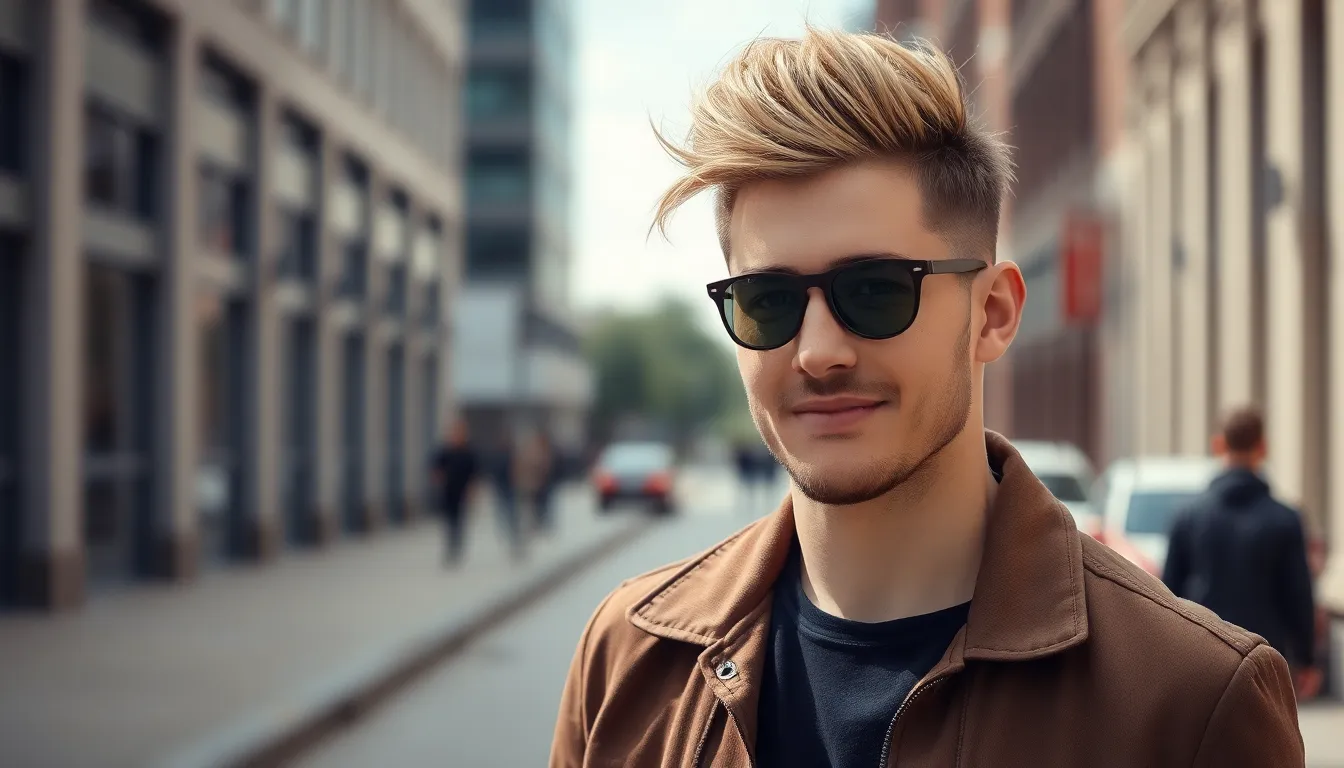
We’ve seen how various undercut styles create stunning visual contrasts, and the fade undercut with long hair on top takes this concept to new heights by offering a dramatic yet refined appearance. This modern style combines ultra-short or faded sides with substantial length on top, creating versatility for man buns, ponytails, or slicked back looks.
Different Fade Lengths and Their Impact
Low fade undercuts start just above the ear and offer a subtle transition that keeps more hair below the parietal ridge. We recommend this conservative option for professionals who want style without drawing excessive attention to their haircut.
Mid fade variations begin midway on the head and provide balanced contrast between sharpness and softness. These cuts work exceptionally well for men who want noticeable style changes without committing to dramatic transformations.
High fade options extend higher up the sides and back, creating bold contrast that makes the long top appear even more voluminous. We find these cuts perfect for men who want edgy, contemporary looks that command attention.
| Fade Type | Starting Point | Style Impact | Maintenance Frequency |
|---|---|---|---|
| Low | Just above ear | Subtle, conservative | Every 3-4 weeks |
| Mid | Midway on head | Balanced contrast | Every 2-3 weeks |
| High | Upper sides/back | Bold, dramatic | Every 2 weeks |
Each fade length affects styling options differently, with low fades offering more conservative versatility and high fades providing maximum contrast for statement looks.
Blending Techniques for Seamless Transitions
Tapering with adjustable clippers creates smooth gradients by switching between guard lengths using the clipper’s adjustable lever. We use this technique to eliminate harsh lines and create natural looking transitions from the faded sides to the long top.
Overlap blending involves slightly overlapping each section as the fade progresses upward, ensuring no visible lines appear in the finished cut. Barbers carefully work each layer into the next, creating seamless flow from the shortest areas to the longest sections.
Scissor over comb refinement polishes the transition between faded sides and longer top sections for professional finishes. We recommend this final step to achieve the precision that separates amateur cuts from expertly crafted fade undercuts.
These blending methods require skill and practice to master, but they’re essential for creating the natural, gradual transitions that make fade undercuts with long hair on top look effortlessly sophisticated.
Long Hair Undercut With Side Part
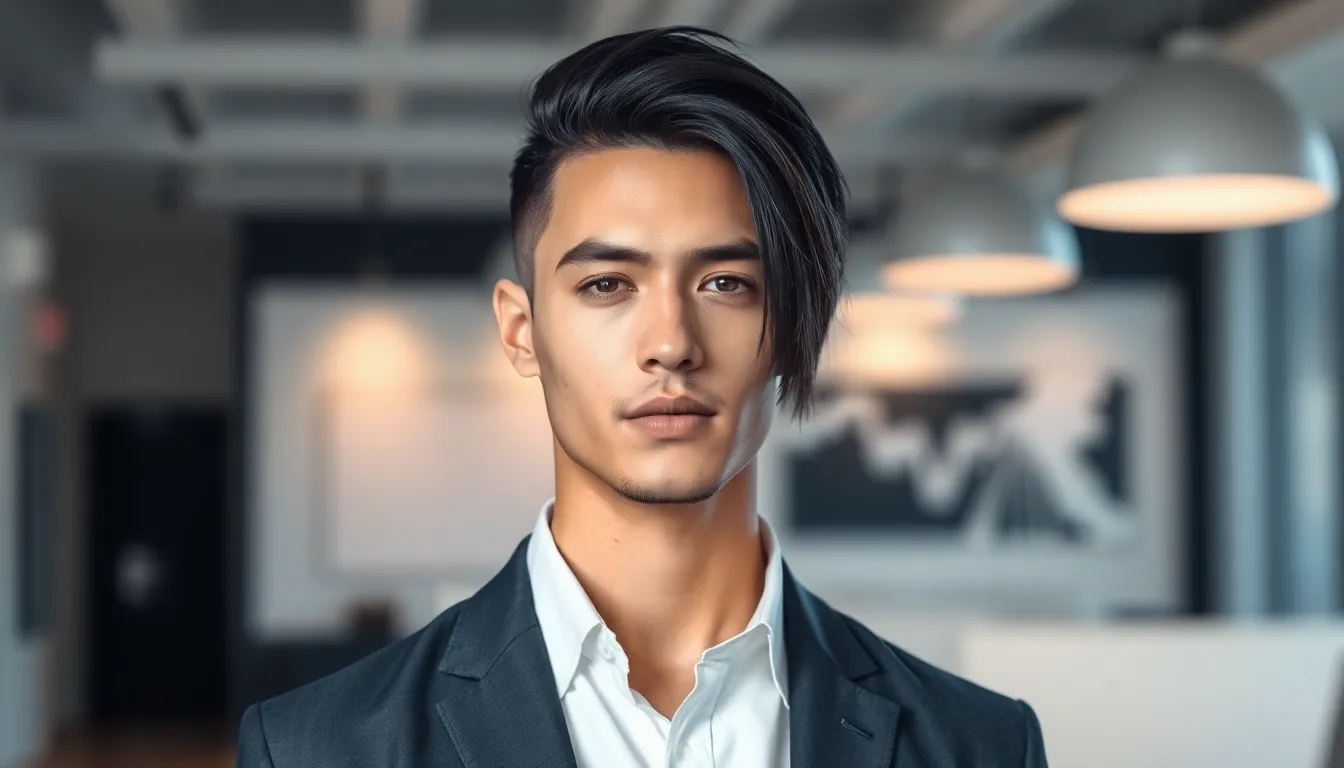
We’ve discovered that adding a side part to your long hair undercut creates one of the most sophisticated and adaptable styles available today. This versatile combination gives you the flexibility to transition seamlessly from casual weekends to important business meetings.
Creating the Perfect Part Line
Determine your hair type first to establish the foundation for your perfect part line. Straight hair typically holds clean, precise parts better than wavy or curly textures, which naturally create softer, more organic divisions.
Use a fine-tooth comb to create sharp, defined lines when working with straight or slightly wavy hair types. Start from your hairline and draw the comb backward in one smooth motion, following your natural growth patterns for the most flattering result.
Apply styling products strategically to lock your part in place and enhance the overall definition. Water-based pomades work excellently for clean, professional looks, while texture sprays help create more natural, lived-in appearances.
Consider your face shape when deciding on part placement, as different positions can dramatically alter your overall appearance. Oval faces benefit from center or slightly off-center parts, while square faces look best with deeper side parts that soften angular features.
Practice consistency by parting your hair in the same location each day to train your hair growth patterns. This technique makes styling faster and more predictable over time.
Professional Styling for Formal Occasions
Create a slicked-back look using strong-hold hair products to emphasize the dramatic contrast between your undercut sides and polished top length. Apply pomade evenly through damp hair, then use a wide-tooth comb to distribute the product while directing hair backward.
Master the side-swept style by applying styling cream to towel-dried hair, then using a paddle brush to sweep your long top hair to one side. This approach creates elegant movement while maintaining professional polish for important meetings or formal events.
Incorporate subtle accessories like discrete hair pins or thin elastic bands when you need extra security for lengthy formal occasions. Position these elements strategically behind your ears or at the nape of your neck to maintain a refined appearance.
Blend textures skillfully by using different products on various sections of your long hair undercut with side part. Apply heavier pomades near your part line for definition, then switch to lighter creams through the mid-lengths for natural movement.
Finish with precision by using a small amount of high-shine product along your part line to create crisp definition that photographs well under formal lighting conditions.
Curly Long Hair With Undercut Sides
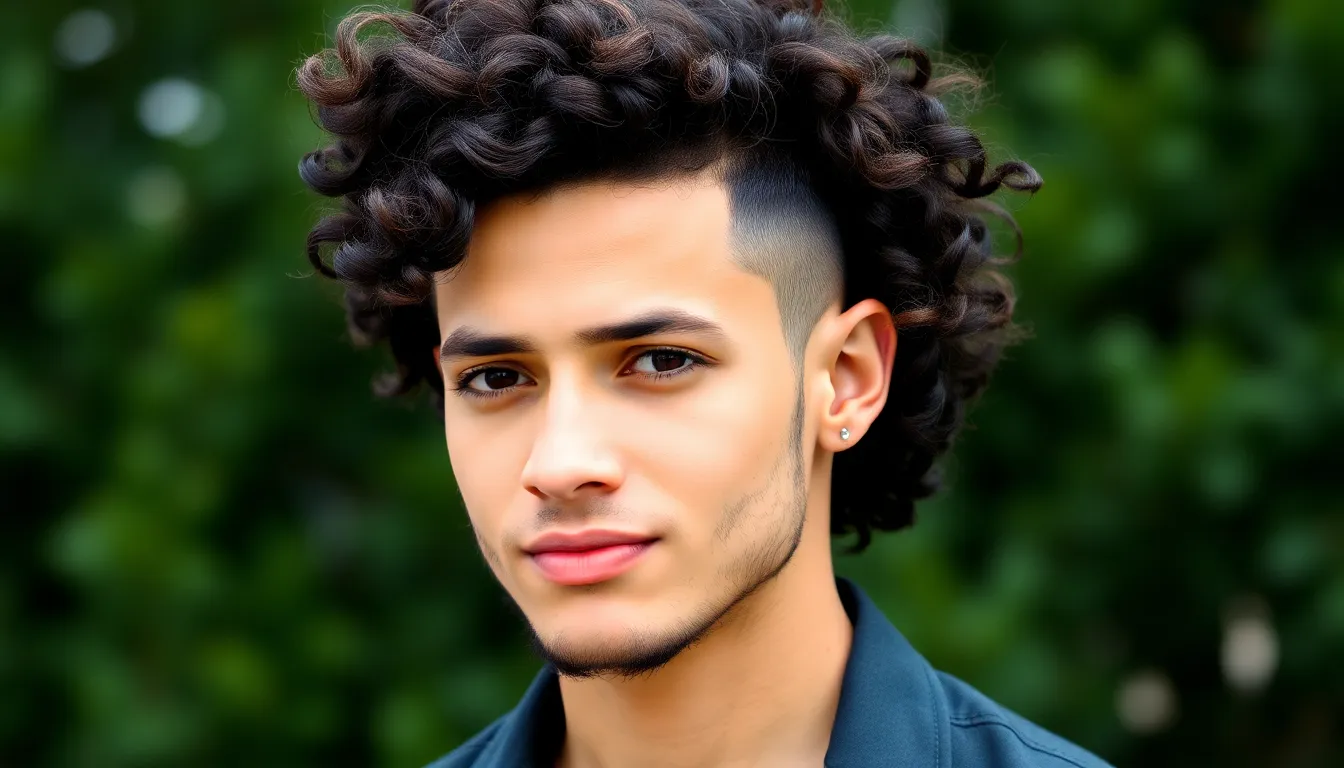
Curly hair paired with undercut sides creates one of the most striking contrasts in men’s hairstyling. We’ve found this combination accentuates natural curl patterns while maintaining a clean, professional appearance that works across various settings.
Managing Curly Texture With Short Sides
Balance becomes crucial when maintaining curly long hair with undercut sides. We recommend keeping sufficient length on top to allow curls to appear full and robust while the contrast with short sides enhances the overall texture.
Undercut styles offer versatility that works exceptionally well with curly hair types. We suggest combining the undercut with fades or tapers to create seamless transitions that complement your natural curl pattern rather than fighting against it.
Regular maintenance keeps the style looking sharp and prevents the curls from overwhelming the cut. We advise scheduling trims every 3-4 weeks to maintain the clean lines of the undercut while allowing the top to grow and develop fuller curl definition.
Professional consultation helps determine the optimal length ratio between your curly top and undercut sides. We’ve observed that most men benefit from maintaining at least 3-4 inches on top to showcase their natural curl texture effectively.
Products and Techniques for Curl Definition
Curl defining creams form the foundation of our recommended product lineup for this style. These formulations add moisture and definition while improving your hair’s natural texture without weighing down the curls.
Styling wax provides the hold and texture control needed for curly undercut styles. We suggest applying a small amount to damp hair, focusing on the mid lengths and ends to add definition without creating stiffness.
| Product Type | Primary Benefit | Application Method |
|---|---|---|
| Curl Defining Creams | Moisture and definition | Apply to damp hair, scrunch gently |
| Styling Wax | Hold and texture | Work through mid lengths to ends |
| Leave-in Conditioner | Frizz control | Distribute evenly when hair is wet |
Diffuser techniques preserve curl integrity during the drying process. We recommend using a diffuser attachment on low heat settings to maintain curl definition while preventing frizz formation that can occur with regular blow drying.
Scrunching methods enhance natural curl patterns when applied correctly. We suggest gently scrunching damp curls upward toward the scalp to encourage curl formation and create volume without disrupting the natural texture.
Application timing affects product performance significantly with curly hair. We’ve found that applying curl defining products to damp (not soaking) hair provides the best results for definition and hold throughout the day.
Layering products creates optimal results when done strategically. We recommend starting with a leave-in conditioner for moisture, followed by curl defining cream for texture, and finishing with a light application of styling wax for hold.
Long Hair Undercut With Shaved Designs
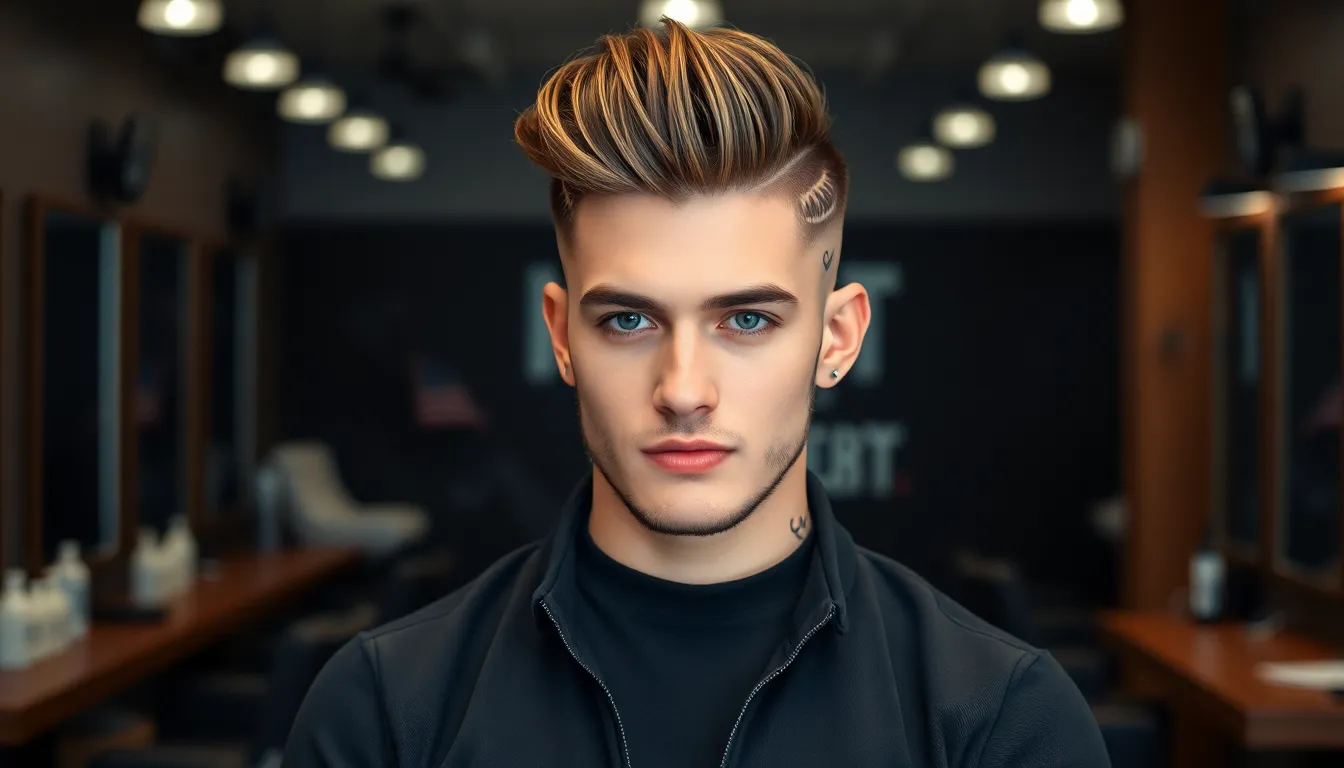
Shaved designs transform the traditional long hair undercut into a personalized canvas for artistic expression. These intricate patterns elevate your hairstyle from stylish to truly unique.
Popular Design Patterns and Trends
Geometric designs lead the way in contemporary undercut artistry, featuring straight lines, triangles, and angular patterns that create a modern, edgy aesthetic. These precise shapes work exceptionally well with the clean contrast between long hair and shaved sides.
Tribal and traditional patterns offer cultural depth and personal meaning to your undercut design. Many men choose tribal inspired motifs combined with contemporary flair, creating a bridge between heritage and modern style.
Textured fades provide a softer alternative to traditional solid shaved areas, where hair gradually shortens instead of creating stark contrasts. This approach appeals to those seeking subtle sophistication while maintaining the undercut’s visual impact.
Man bun and half up styles frequently pair with shaved designs for added versatility and functionality. The combination allows you to showcase intricate patterns when hair is styled up or conceal them when wearing hair down.
Asymmetrical cuts complement shaved designs through uneven or side swept long hair placement over the undercut. This technique works whether you prefer bold geometric elements or subtle, natural looking patterns.
Working With Your Barber for Custom Designs
Consultation sessions form the foundation of successful custom undercut designs, requiring thorough discussion of your vision before any cutting begins. Bring reference images and describe your desired style in detail to ensure clear communication.
Hair length considerations matter significantly since top hair must be long enough to cover the undercut when worn down if you prefer that option. We recommend maintaining at least 4 to 6 inches on top for maximum styling flexibility.
Design precision demands choosing a barber skilled in shaved artwork, as intricate patterns require steady hands and extensive experience. Look for portfolios showcasing similar work and ask about their training in detailed clipper techniques.
Maintenance requirements include regular touch ups every 2 to 3 weeks to keep undercut edges crisp and designs sharp. Factor this ongoing commitment into your grooming budget and schedule.
Product recommendations from your barber may include pomades, waxes, or gels to style the long hair and enhance the overall look. These products help maintain the contrast between textured top sections and clean shaved designs.
Maintenance and Styling Tips for Long Hair Men Undercuts
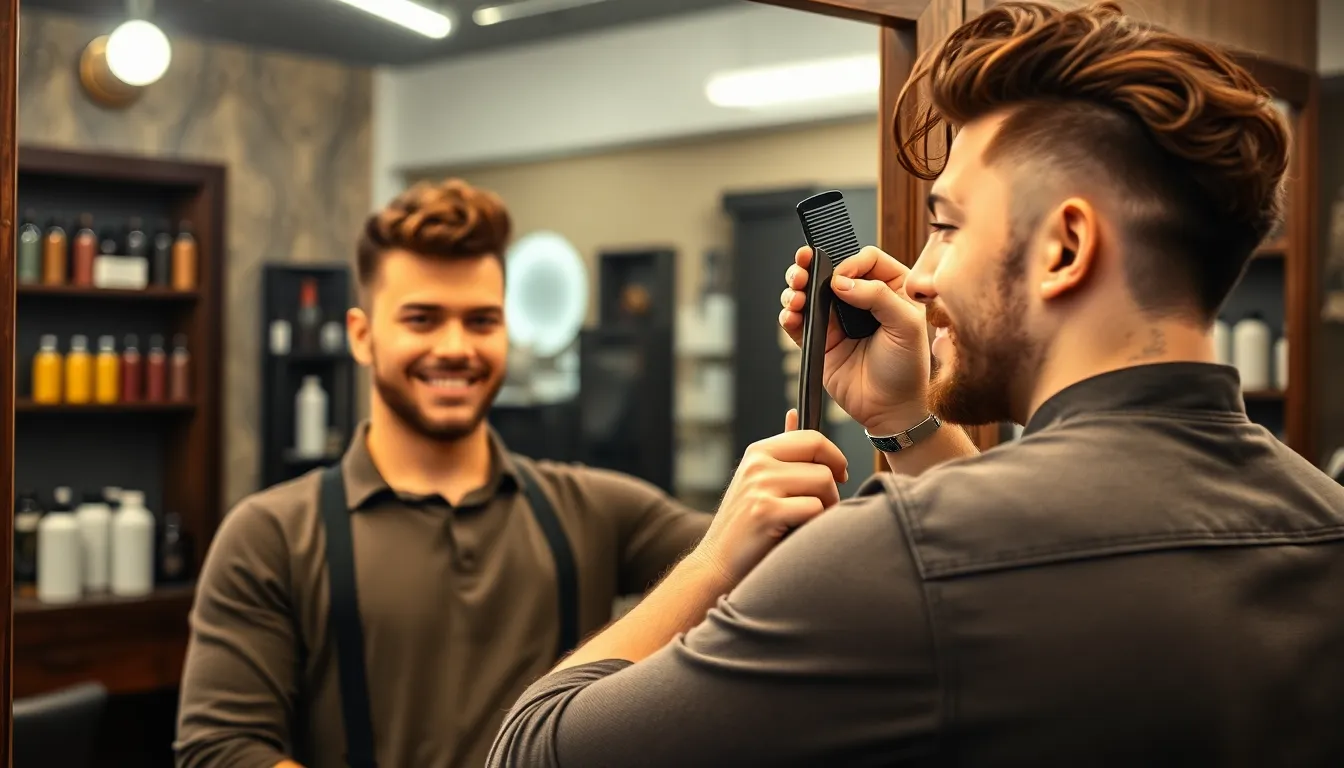
Maintaining your long hair undercut requires consistent care and strategic styling to preserve the dramatic contrast that makes this look so striking. We’ll walk you through the essential maintenance schedule and daily styling routine that keeps your undercut looking sharp and professional.
Regular Trimming Schedule and Touch-Ups
Schedule touch-ups every 2-4 weeks to maintain the clean contrast between your long top and short sides. Individual hair growth rates determine whether you need more frequent visits, but this timeframe ensures your undercut stays crisp and defined.
Visit your barber regularly for professional maintenance of the sides and back sections. Professional stylists use clippers to refresh the undercut and blend transitions for a polished finish that prevents the style from looking messy or overgrown.
Handle minor touch-ups at home using clippers with guards between salon visits. Focus on the sides and back areas, keeping them tight to maximize the contrast with your longer top section.
Prevent overgrowth by monitoring your hair’s natural growth pattern and booking appointments before the sides lose their sharp definition. Waiting too long between trims can compromise the dramatic effect that makes this style so appealing.
Daily Styling Routine and Product Recommendations
Wash your hair with quality shampoo and conditioner designed specifically for long hair to prevent dryness and maintain healthy locks. Use a double wash technique during each session: focus the first wash on roots to remove dirt and oil, then lather again for thorough cleansing.
Apply conditioner from mid-length to ends and let it sit before rinsing thoroughly to ensure your long hair stays moisturized and manageable. This prevents the top section from becoming dry or brittle while the shorter sides remain fresh.
Towel dry or blow dry your hair before applying styling products to create the foundation for your desired look. Work wax or pomade through the top hair to add definition and shape, using a comb to smooth unruly areas and direct hair into place.
Choose products based on your hair type and style preference to achieve the best results:
| Product Type | Best For | Finish |
|---|---|---|
| Pomade | Slick, polished styles | High shine |
| Wax | Flexible hold and texture | Matte to medium shine |
| Texture spray | Volume and separation | Natural, matte |
Apply products strategically by working them through damp hair for even distribution and better hold. Start with a small amount and build up as needed to avoid weighing down your hair or creating a greasy appearance.
Conclusion
The long hair undercut represents the perfect fusion of classic sophistication and contemporary style. We’ve explored how this versatile cut adapts to every lifestyle – from professional boardrooms to weekend adventures. Whether you prefer the sleek elegance of a slicked-back style or the artistic flair of braided elements each variation offers unique opportunities for self-expression.
What makes this hairstyle truly exceptional is its adaptability. We’ve seen how it complements different face shapes hair textures and personal preferences while maintaining that sharp contrast that defines the look. The key lies in finding the right combination of length texture and styling approach that works for your individual needs.
Remember that achieving and maintaining these styles requires commitment to regular upkeep and quality products. With the right techniques and tools you’ll master a look that’s both timeless and thoroughly modern – a hairstyle that truly makes a statement.
Frequently Asked Questions
What is a long hair men’s undercut?
A long hair men’s undercut is a versatile hairstyle that combines substantial length on top with clean-shaved or faded sides. This creates a striking contrast that offers both styling flexibility and a sophisticated appearance. The style works well with various hair textures and face shapes, making it suitable for both professional and casual settings.
How often should I trim my long hair undercut?
You should trim your long hair undercut every 2-4 weeks to maintain the clean contrast between the long top and short sides. The sides typically need more frequent touch-ups every 2-3 weeks, while the top can go longer between trims. Regular maintenance prevents overgrowth and keeps the style looking sharp and professional.
What products work best for styling a long hair undercut?
The best products depend on your desired finish and hair type. Water-based pomades offer flexible hold and easy washability, while oil-based pomades provide stronger hold and shine. Texture sprays and sea salt sprays work well for messy, natural looks. Hair wax and styling creams are excellent for separation and definition.
Can curly hair work with an undercut?
Yes, curly hair works exceptionally well with undercuts, creating a striking contrast between textured curls on top and clean sides. The key is maintaining sufficient length on top to showcase your natural curl patterns. Use curl-defining creams and leave-in conditioners to enhance definition while controlling frizz for a polished appearance.
How do I choose the right undercut style for my face shape?
Face shape determines the best undercut variation for you. Oval faces suit most styles with medium-height styling. Square faces benefit from rounded, softer styles. Round faces look best with height and angular elements. Triangular faces should opt for lower, more balanced styles. Consider consulting a professional barber for personalized recommendations.
What’s the difference between a fade and a disconnected undercut?
A fade creates a gradual transition from short to long hair, blending seamlessly between lengths. A disconnected undercut has a sharp, dramatic contrast with no blending between the short sides and long top. Fades offer a softer, more professional look, while disconnected cuts provide bold, edgy aesthetics with striking visual separation.
How do I maintain the contrast between long top and short sides?
Maintain contrast through regular trims, proper product application, and daily styling routines. Use quality shampoo and conditioner, apply styling products based on your hair type, and employ proper drying techniques. Monitor hair growth closely and schedule touch-ups before the contrast becomes too subtle or overgrown.
Can I add designs to my undercut?
Yes, shaved designs can transform your undercut into personalized artistic expression. Popular options include geometric shapes, tribal motifs, and textured patterns. Work with a skilled barber for custom designs and expect more frequent maintenance every 2-3 weeks. Designs add cultural depth and modern flair to traditional undercut styles.
